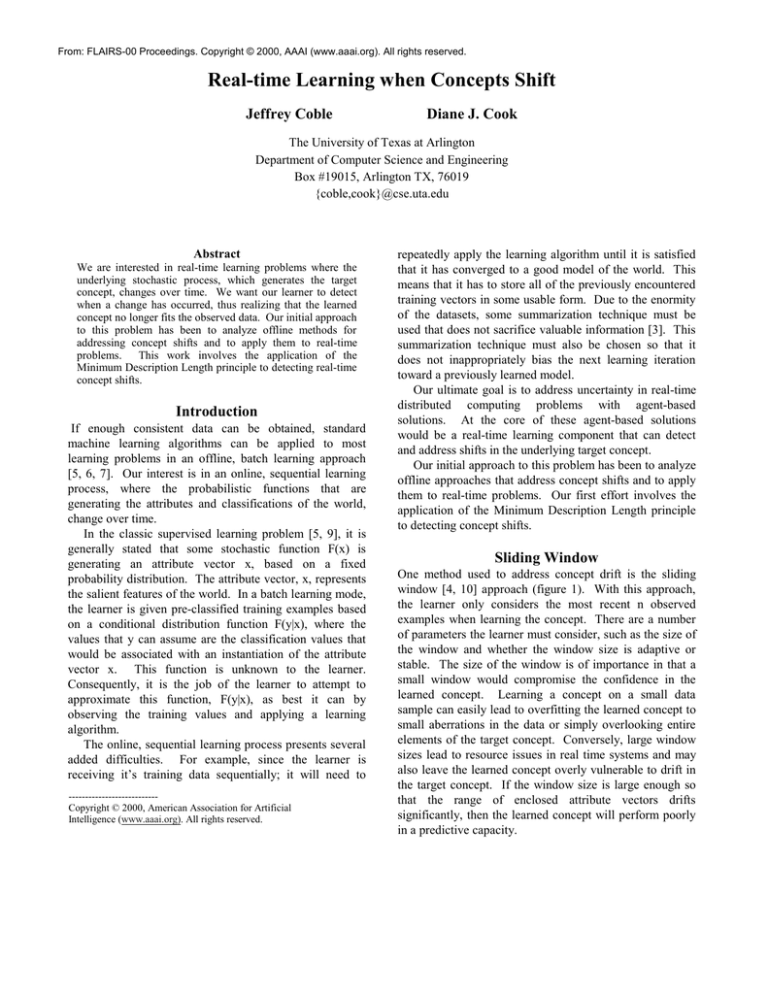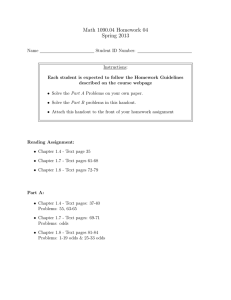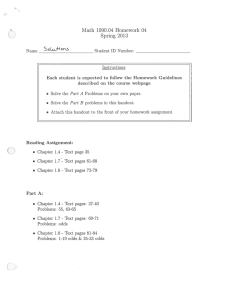
From: FLAIRS-00 Proceedings. Copyright © 2000, AAAI (www.aaai.org). All rights reserved.
Real-time Learning when Concepts Shift
Jeffrey Coble
Diane J. Cook
The University of Texas at Arlington
Department of Computer Science and Engineering
Box #19015, Arlington TX, 76019
{coble,cook}@cse.uta.edu
Abstract
We are interested in real-time learning problems where the
underlying stochastic process, which generates the target
concept, changes over time. We want our learner to detect
when a change has occurred, thus realizing that the learned
concept no longer fits the observed data. Our initial approach
to this problem has been to analyze offline methods for
addressing concept shifts and to apply them to real-time
problems. This work involves the application of the
Minimum Description Length principle to detecting real-time
concept shifts.
Introduction
If enough consistent data can be obtained, standard
machine learning algorithms can be applied to most
learning problems in an offline, batch learning approach
[5, 6, 7]. Our interest is in an online, sequential learning
process, where the probabilistic functions that are
generating the attributes and classifications of the world,
change over time.
In the classic supervised learning problem [5, 9], it is
generally stated that some stochastic function F(x) is
generating an attribute vector x, based on a fixed
probability distribution. The attribute vector, x, represents
the salient features of the world. In a batch learning mode,
the learner is given pre-classified training examples based
on a conditional distribution function F(y|x), where the
values that y can assume are the classification values that
would be associated with an instantiation of the attribute
vector x. This function is unknown to the learner.
Consequently, it is the job of the learner to attempt to
approximate this function, F(y|x), as best it can by
observing the training values and applying a learning
algorithm.
The online, sequential learning process presents several
added difficulties. For example, since the learner is
receiving it’s training data sequentially; it will need to
--------------------------Copyright © 2000, American Association for Artificial
Intelligence (www.aaai.org). All rights reserved.
repeatedly apply the learning algorithm until it is satisfied
that it has converged to a good model of the world. This
means that it has to store all of the previously encountered
training vectors in some usable form. Due to the enormity
of the datasets, some summarization technique must be
used that does not sacrifice valuable information [3]. This
summarization technique must also be chosen so that it
does not inappropriately bias the next learning iteration
toward a previously learned model.
Our ultimate goal is to address uncertainty in real-time
distributed computing problems with agent-based
solutions. At the core of these agent-based solutions
would be a real-time learning component that can detect
and address shifts in the underlying target concept.
Our initial approach to this problem has been to analyze
offline approaches that address concept shifts and to apply
them to real-time problems. Our first effort involves the
application of the Minimum Description Length principle
to detecting concept shifts.
Sliding Window
One method used to address concept drift is the sliding
window [4, 10] approach (figure 1). With this approach,
the learner only considers the most recent n observed
examples when learning the concept. There are a number
of parameters the learner must consider, such as the size of
the window and whether the window size is adaptive or
stable. The size of the window is of importance in that a
small window would compromise the confidence in the
learned concept. Learning a concept on a small data
sample can easily lead to overfitting the learned concept to
small aberrations in the data or simply overlooking entire
elements of the target concept. Conversely, large window
sizes lead to resource issues in real time systems and may
also leave the learned concept overly vulnerable to drift in
the target concept. If the window size is large enough so
that the range of enclosed attribute vectors drifts
significantly, then the learned concept will perform poorly
in a predictive capacity.
Lastly, it seems that the sliding window approach is
much better suited to concept drift, rather than concept
Sliding window of size n
One example of an application in this area is dynamic
network routing. Real-time learning agents could be
Current attribute
vector
t-n
Time
t-1 t
Figure 1. Addressing real-time concept drift/shift with a sliding window
approach. The learner only considers the most recent n attribute vectors.
shift. Concept drift occurs when the target concept
changes gradually, whereas concept shift occurs when the
target concept changes instantly. Instantaneous change in
the target concept would leave the learned concept open to
error until the entire window was drawn from the new
target concept.
Problem Domain
The goal of our research is to create highly adaptable, realtime distributed computer systems. The benefits of this
work could be realized through improved network data
transmission speeds, greater autonomous control and
coordination in satellite constellations and robot
applications, and greater reliability in wireless
communication, just to name a few.
Even under controlled conditions, distributed
computing issues, such as maintaining global state and
determining causality among a series of events, are fraught
with difficulty. There are known algorithms for addressing
these problems, however they are designed to work in
environments where communication reliability is
guaranteed and processors never fail. These algorithms
quickly fail when a distributed computing application is
introduced into a volatile environment, in which
communication links may be unstable, the number of
nodes may change, or adversaries may introduce errors
into the communication channel.
Our research addresses the need for autonomous
adaptability in real-time environments by introducing
specialized intelligent agent technology into the distributed
computing arena. Using this technology, we are providing
a method for coping with uncertainty in order to address
real-time adaptability issues.
deployed at network routers so that they may learn to adapt
routing patterns on-the-fly as traffic patterns change. For
instance, traffic patterns may change with the time of day
or due to an anomalous event, such as an outage in one
part of the network. The growth of Internet use also
causes traffic patterns to change in ways that have yet to be
foreseen. Adaptive agents could reduce network downtime, provide greater throughput, and improved customer
service.
Our initial approach has been to use a very popular
problem, known as the ‘the bandit problem’ [1]. The
bandit problem refers to the notion of a slot machine,
which is a stochastic process with an unknown chance for
payoff.
The bandit problem has many variations but for the
purposes of this work, let it be defined as follows:
•
•
•
•
•
•
Let there be two or more arms, where each arm is a
stochastic process that can be in state 0 or 1.
State 0 produces a corresponding reward of 0. State 1
produces a corresponding reward of 1.
When an agent selects an arm, it receives the reward
produced by the arm in its current state.
Selecting an arm causes it to transition to a new state
with some fixed probability. There is no correlation
between the probability distribution governing each of
the two arms
The selection of one arm does not affect the state of
the other arm.
The agent may make N total selections, with the
objective of maximizing its total reward. This is
typically called an N-horizon problem.
•
Each arm starts in a random state, selected according
to its probability distribution.
This problem provides a simple testing ground for our
machine learning research and is the subject of this initial
work.
Bandit Simulator
For the purpose of experimentation, we have developed a
k-armed bandit simulator. The simulator allows the user to
by the agent in response to spending a pull on the arm. The
agent uses the observed result to update its belief about the
arm’s odds. If a single arm is played enough times, this
value should converge to the value of the odds parameter
for the arm. Currently, the agent computes a Beta density
function for an arm after it is pulled. This function is used
to formulate a belief as to the payoff odds for each arm.
The agent assumes a uniform prior belief on the payoff
odds of each arm. The agent always selects the arm for
which it has the highest belief about payoff.
Figure 2. k-armed bandit simulator.
add any number of arms where each arm can be configured
with the following parameters:
Odds: The arm’s actual odds of paying off. The arm is a
Bernoulli Process, in that it generates independent results
of the form "win or lose". The odds parameter is the true
likelihood that the arm will produce a "win".
Payoff: This parameter is simply the value (number of
wins)/(number of plays). In other words, it is the
percentage of times this arm has produced a win. It should
converge to the same value as the odds parameter over
time.
Belief: This parameter is the agent’s belief about the
likelihood of the arm paying off. This value is calculated
For the purposes of this work, we also want to generate
a concept shift. This is realized by changing the “Odds”
parameter to a new value during play. An arm can be
configured with the following parameters, designed to
facilitate concept shifts:
Initial Payoff: The starting “Odds” value for the arm.
Amount of change: By how much the “Odds” will
change at each shift.
Direction of change: Values of “increment” or
“decrement” can be selected. This value indicates whether
to add or subtract the “Amount of change” to/from the
“Initial Payoff” value.
# of examples per segment: The number of examples that
will be included in each stable target concept. A segment
refers to a section of stable target concept values, in this
case simply a stable “Odds” value.
# of segments: The number of concept shifts.
3.
4.
5.
MDL Approach
In [2], the authors present an approach for detecting the
boundaries between segments in data mining problems. A
segment represents data that was generated by a consistent
process or system. For example, a coin with a 50-50 bias
will roughly generate an equal number of <heads> and
<tails> outcomes. When the bias changes, the data will
obviously reflect this change and we consequently call this
a segment shift. The author’s original motivation for this
algorithm was to detect surprising patterns in data mining
problems.
The algorithm presented in [2] is based on the
Minimum Description Length (MDL) principle [8]. In this
section we describe the basic MDL algorithm for detecting
concept shifts.
Each data item is represented as a tuple of boolean
variable values. An example of a four variable item set
might be <true, false, false, true>, where each boolean
value represents the presence or absence of the particular
variable. Each data tuple, containing k variables, can be
thought of as being generated by a 2k-sided coin or k twosided coins. We will discuss the algorithm with respect to
a tuple size of one variable. In other words, a single biased
coin where the outcome is either <heads> or <tails>.
The underlying premise of the algorithm is that the
segmentation
and coin parameters that minimize C(M) +
r
2
C( x | M) can be computed
r in O(T ), where T represents
the number of tuples, x is the data set, and M is the
model. C(M)
represents the cost of encoding the model
r
while C( x |M) represents the cost of encoding the data,
given the model. By finding the parameters that minimize
the cost, the MDL algorithm finds the optimal
segmentation. The costs are computed for each possible
segmentation. We paraphrase the steps in the algorithm
from [2] as follows:
1.
2.
Construct a directed acyclic graph (DAG) with T+1
nodes, and directed edges (i, j), for all 0 ≤ i < j ≤ T.
Each edge is weighted with the cost, c(i,j),
representing the model and data encoding costs for the
data items between between i (exclusive) and j
(inclusive).
Find Model Parameters, p1(i, j) and p0(i,j), where p1(i,
j) is the probability of <heads> between data items i
and j and p0(i,j) is the probability of tails. These
values are calculated from the data as follows: p1(i,j) =
h1(i, j) t(i, j) , where h1(i,j) is the number of <heads>
6.
7.
between data items i and j and t(i,j) is the total number
of data items between i and j. p0(i,j) = 1- p1(i,j).
Find Data Encoding Cost for segment (i,j). Applying
Shannon’s
theorem with the parameters above yields:
r
C( x | M) = − ∑ pxlogpx , where x = 0, 1.
Find Parameter Encoding Cost. One of the values
p0(i,j) or p1(i,j) must be transmitted. Since the
maximum likelihood estimate for p1(i,j) can only
assume t(i,j)+1 values, the parameter encoding cost
can be estimated as log(t(i,j)) bits.
Find Segmentation Costs. The boundaries of each
segment must also be encoded. For k coins, this value
is estimated as klogT.
Find Shortest Path. The shortest path through the
graph is calculated in O(T2) time, where each edge in
the shortest path is a segment boundary.
This approach can be extended to tuples of size k by
modifying the way in which the edge weights are
calculated. The most substantial modification stems from
the fact that with an increased number of variables, the
number of possible models grows. The model encoding
costs must be calculated for each model in order to choose
the best. The authors present a simple heuristic for
circumventing this problem. They simply reuse the best
model from the itemset of k-1 and only consider
generalizations of this model.
To evaluate this learning method in a real-time setting,
we have reduced the bandit problem to one arm, in order to
constrain the problem to that of simply learning one
shifting target concept in real-time, rather than the arduous
task of selecting the best of many learned concepts. Our
experimentation has yielded some promising results but
has also shown the need for substantial further work.
Results
As expected, the MDL solution degrades with respect to
the size of the shift and the number of examples in each
segment. As the shift in the target concept becomes less
than 0.3 (30%), the segmentation boundaries become
increasingly less accurate. Furthermore, as the number of
examples in the new segment decrease below 50, the
segmentation boundaries again become less accurate.
With shifts larger than 0.3 and segment sizes approaching
100 examples, the MDL approach finds the segmentation
boundaries with nearly perfect accuracy.
The primary issue with the MDL approach is its
demand on computational resources. The search for the
least costly segmentation is accomplished by constructing
a graph with T nodes and O(T2) edges, computing costs for
each edge, and finding the shortest path through the graph
with the weighted edges. Obviously the performance of
this solution degrades rapidly as the dataset grows.
Conclusions and Future Work
We are encouraged by the accuracy of the MDL approach
for detecting concept shifts. We believe that this solution
has many areas in which optimization and summarization
techniques can be applied to reduce the computational
overhead involved, making this a workable solution to
real-time learning problems.
One solution might be to apply summarization
techniques to the graph so that the number of edges could
be significantly reduced. Since the costs of many edges
are simply composites of collections of edges, this seems
like a very viable approach. Another alternative might be
to apply the sliding window approach, used in concept
drift, to this concept shift problem. If we limit our
‘relearning’ process to a window size that will yield
acceptable accuracy while keeping computational costs
low, the MDL approach may work well in real time.
Clearly the one-armed bandit test is very simple and
our research must be expanded to substantially complex
concepts. These issues will be addressed in our ongoing
work in this area.
Reference
1.
2.
3.
4.
5.
6.
7.
Berry, D. A., and Fristedt, B., Bandit Problems:
Sequential Allocation of Experiments, Chapman and
Hall, London, UK, 1985.
Chakrabarti, Soumen, Sarawagi, Sunita, Dom, Byron:
Mining Surprising Patterns Using Temporal
Description Length. Proceedings of 24th International
Conference on Very Large Data Bases, August 24-27,
1998, New York City, New York, USA. Morgan
Kaufmann 1998: 606-617
Friedman, Nir and Goldszmidt, Moises, Sequential
Update of Bayesian Network Structure, In the
Proceedings of the Thirteenth Conf. on Uncertainty in
Artificial Intelligence (UAI 97).
Klinkenberg, Ralf and Renz, Ingrid, Adaptive
Information Filtering: Learning Drifting Concepts.
Beiträge zum Treffen der GI-Fachgruppe 1.1.3
Maschinelles Lernen (FGML-98), Wysotzki, F. and
Geibel, P. and Schädler, K. (ed.), Forschungsberichte
des Fachbereichs Informatik, 98/11, Fachbereich
Informatik, TU Berlin, 1998.
Mitchell, Tom. Machine Learning. McGraw Hill,
1997.
Quinlan, J. Ross, C4.5: Programs for Machine
Learning. Morgan Kaufmann, San Mateo, CA, USA,
1993.
Russell, Stuart and Norvig, Peter, Artificial
Intelligence: A Modern Approach, Englewood Cliffs,
NJ: Prentice Hall Inc, 1995.
8.
Shannon, C. E. and Weaver, W., The Mathematical
Theory of Communication. Urband: University of
Illinois Press, 1949.
9. Vladimir N. Vapnik. The Nature of Statistical
Learning Theory. Springer, New York, NY, USA,
1995.
10. Widmer, G. and Kubat, M., Learning in The Presence
of Concepts Drift and Hidden Contexts, Machine
Learning, 323, 69-101 (1996).






